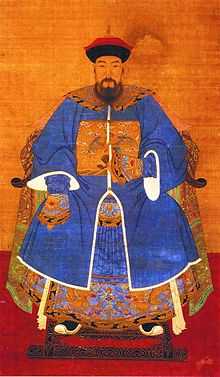Hong Chengchou
| Hong Chengchou | |
|---|---|
 Portrait | |
| Born |
1593 Nan'an, Fujian, Ming Dynasty, China |
| Died |
1665 Nan'an, Fujian, Qing Dynasty |
| Years of service | 1630–1650 |
| Rank |
Prime Minister, 1636 Field Marshal 1640 |
| Battles/wars |
Battle of Songjin,1640-1641 Battle of Shanhai Pass,1644 |
Hong Chengchou or Hung Cheng-chou (Chinese: 洪承疇; pinyin: Hóng Chéngchóu; Pe̍h-ōe-jī: Hông Sêng-tiû; born 1593 - died 1665) was a military commander from Fujian at the end of the Ming Dynasty.
Biography
Hong Chengchou was a native of Fujian who rose to the top military post by leading campaigns against the rebels in the 1620s. He was also a leading thinker on military strategy and a proponent (like Yuan Chonghuan, Xu Guangqi and Sun Yuanhua) of the adoption of European cannon by the Ming army.
Military career
Fighting Rebels
Hong Chengchou was the Governor of Shannxi and Sanbian, responsible for fighting Li Zicheng and other rebels. He was successful in defeating Li at the Battle of Tongguan Nanyuan in 1638, after which Li fled with only 18 men. After the battle, he was transferred to the North to fight the invading Manchus.
Battle of Shanhai Pass
The Manchu raids into China brought them treasures, food, and live stocks, but the logistical difficulties along the circuitous invasion route through the Inner Mongolian deserts (in order to bypass the Ming garrisons of Shanhaiguan, Ningyuan, and Jinzhou along the Bohai littoral) made it difficult for the Manchus to hold onto their territorial conquests.
The Shanhaiguan corridor remained the best invasion route for the Manchus and therefore Huang Taiji needed to eliminate those Ming fortresses, the first one being Jinzhou. To save the vital fortress, the Ming court sent an army of over 130,000 men under Hong Chengchou to lift the siege. Unfortunately, in a series of skirmishes, Huang Taiji's Manchus massacred the flower of the Ming Army. First, Manchu cavalry raided the Ming's granary in the rear, and when the Ming Army retreated after it ran out of food, Huang Taiji placed ambush forces along the Ming Army's retreat routes and massacred the retreating Ming soldiers at night.
Hong Chengchou surrendered to the Qing Dynasty in 1642, after being captured in the siege of Songshan (Battle of Songshan). Prior to his surrender, he was the governor-general of northeastern Zhili and Liaodong. He was attempting to assist Ming General Zu Dashou who was besieged in the city of Jinzhou. Hong was assigned to the Chinese bordered yellow banner. A fake report of his death reached the Ming Emperor (Chongzhen Emperor) who ordered a temple be built to honour his name.
Hong's capture was the third big disaster for the Ming military since the execution of Yuan Chonghuan, and the defection of Geng Zhongming and Shang Kexi to the Manchus (which also led to the execution of Sun Yuanhua as a scapegoat).
Service to Qing
After his surrender, Hong was made an official only after the Qing occupied Beijing. In 1645, Hong was sent to Nanjing with the title Pacificator of Jiangnan. His real role in the military was to ship supplies, nonetheless he suppressed many Ming officials and members of the Southern Ming imperial family.
Hong was several times accused of having secret relations with the Ming. He was in 1651 chastised for sending his mother back to Fujian and in 1652 was not allowed to return to his native Fujian to mourn his mother death. Although appointed governor-general of 5 provinces of Huguang, Guangdong, Guangxi, Yunnan and Guizhou, his real task again was to provide for the army.
In 1659, he was recalled to Beijing after he declined to press the war in Yunnan to capture Yongli Emperor from Southern Ming Dynasty who had fled to Burma. Wu Sangui, which previous was the Ningyuan garrison commander and one of Hong Chengchou's eight subordinate generals, replaced him.
Hong Chengchou was given a minor hereditary rank perhaps due to distrust by some quarters of the Court, who suspected him of sympathesing with the Ming.
Death
Hong Chengchou died shortly after requesting permission to retire because of old age and almost full blindness. He died by natural causes in Nan'an, Fujian province on 1665. His tomb is unknown.
References
- China Forum History, "Fan Haomin" July 2007.
- History of China Defense, "Showdown on ShanhaiGuan" ; The Northeast and the Enigmatic Wu Sangui. (By cao cao)
- The Life and Career of Hung Ch'Eng-Ch'Ou, 1593-1665: Public Service in a Time of Dynastic Change (Monograph and Occasional Paper Series) ISBN 978-0-924304-40-8